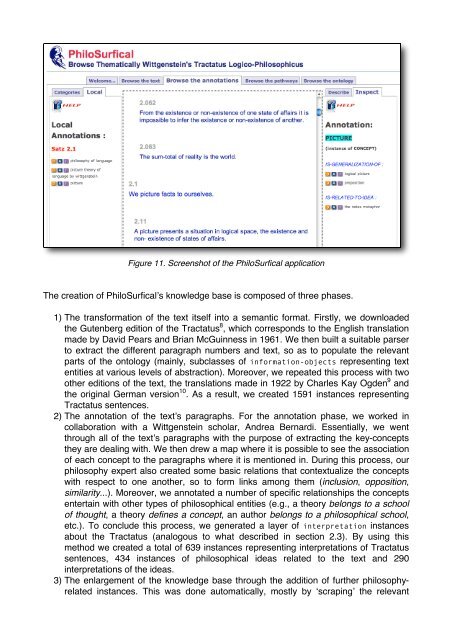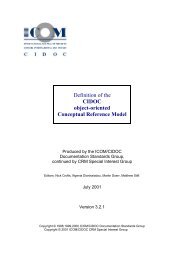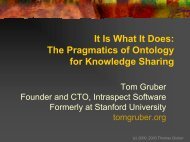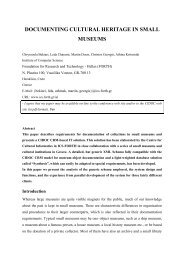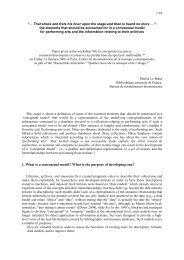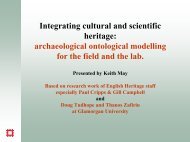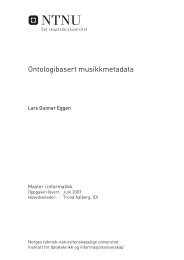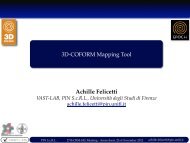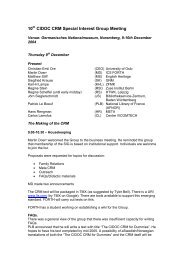organized differently if investigated under a problem-centered perspective, a theorycenteredone, or simply one based on their historical succession.In other words, our approach takes the notion of a ʻdigital narrativeʼ7 (Brooks, 1996) <strong>and</strong>attempts to transpose it to the specific scenario made up of philosophical entities.Accordingly, with PhiloSurfical we aimed at creating a virtual environment <strong>for</strong> exploringuser-triggered digital narratives, which we also call learning pathways.Because of space limitations, we cannot give here a complete description of all thepathways made available in PhiloSurfical. In order to better underst<strong>and</strong> the role <strong>and</strong> usageof the ontology within the software tool, we will instead focus on the construction of aTractatus-related knowledge base <strong>and</strong> on the functioning of a specific type of learningpathways, the theoretical ones (cf. table 1 below).4.1 Creating a knowledge base <strong>for</strong> the TractatusAlthough the ontology was created with the aim of facilitating data-exchange amongdistributed resource-providers, <strong>for</strong> bootstrapping purposes (as the availability of free <strong>and</strong>adequately encoded ʻphilosophicalʼ data on the web is still limited), PhiloSurfical stronglyrelies on an internal knowledge base of our creation.Be<strong>for</strong>e going further, an important clarification has to be made. By instantiating theontology with various Tractatus-related data we inevitably created a ʻunifiedʼ philosophicalview of this text, in the sense that we had to privilege certain interpretations instead ofothers. Certainly, such a result is not representative of the reality, where the amount ofcritical literature on this influential text is just enormous. Thus, consistently with whatemphasized in section 1, our views on the Tractatus have no pretension whatsoever to berepresentative of all the literature, or to be truer than others. In general, we just aimed atcreating a pedagogical resource that could be used as an introduction to the Tractatus.Accordingly, we stopped refining the knowledge base as soon as we thought we hadreached a critical mass of data, usable <strong>for</strong> testing our ʻlearning pathwaysʼ approach.It also is useful to point out that in this respect our work differs radically from other digitaleditions of Wittgensteinʼs works, e.g., Bazzocchiʼs Tractatus (Bazzocchi, 2007) or thefamous Bergen edition of the Nachlass (Pichler, 2002). Our aim was simply to test thequality of the ontology by instantiating it with real-world philosophical data. <strong>The</strong> otherdigital editions focus instead on creating a new version of a classic text, usually by takingadvantage of various features of the digital medium.<strong>The</strong> key difference here is that our research interest concerns the modeling <strong>and</strong> integrationof philosophical data in an open context like the Semantic Web. Within such a scenario,the Tractatus is <strong>for</strong> us just a ʻh<strong>and</strong>yʼ testbed <strong>for</strong> the instantiation of the ontology (first of all,because it is a highly structured text, thus simplifying the analytical task of dissecting it intomeaningful units). On the contrary, the digital editions mentioned above do not makeavailable the (implicit) semantic model used in building the application, that is, they do notpresent it in the <strong>for</strong>m of an ontology that others can reuse, modify or employ <strong>for</strong>exchanging philosophical data.
Figure 11. Screenshot of the PhiloSurfical application<strong>The</strong> creation of PhiloSurficalʼs knowledge base is composed of three phases.1) <strong>The</strong> trans<strong>for</strong>mation of the text itself into a semantic <strong>for</strong>mat. Firstly, we downloadedthe Gutenberg edition of the Tractatus 8 , which corresponds to the English translationmade by David Pears <strong>and</strong> Brian McGuinness in 1961. We then built a suitable parserto extract the different paragraph numbers <strong>and</strong> text, so as to populate the relevantparts of the ontology (mainly, subclasses of in<strong>for</strong>mation-objects representing textentities at various levels of abstraction). Moreover, we repeated this process with twoother editions of the text, the translations made in 1922 by Charles Kay Ogden 9 <strong>and</strong>the original German version 10 . As a result, we created 1591 instances representingTractatus sentences.2) <strong>The</strong> annotation of the textʼs paragraphs. For the annotation phase, we worked incollaboration with a Wittgenstein scholar, Andrea Bernardi. Essentially, we wentthrough all of the textʼs paragraphs with the purpose of extracting the key-conceptsthey are dealing with. We then drew a map where it is possible to see the associationof each concept to the paragraphs where it is mentioned in. During this process, ourphilosophy expert also created some basic relations that contextualize the conceptswith respect to one another, so to <strong>for</strong>m links among them (inclusion, opposition,similarity...). Moreover, we annotated a number of specific relationships the conceptsentertain with other types of philosophical entities (e.g., a theory belongs to a schoolof thought, a theory defines a concept, an author belongs to a philosophical school,etc.). To conclude this process, we generated a layer of interpretation instancesabout the Tractatus (analogous to what described in section 2.3). By using thismethod we created a total of 639 instances representing interpretations of Tractatussentences, 434 instances of philosophical ideas related to the text <strong>and</strong> 290interpretations of the ideas.3) <strong>The</strong> enlargement of the knowledge base through the addition of further philosophyrelatedinstances. This was done automatically, mostly by ʻscrapingʼ the relevant


